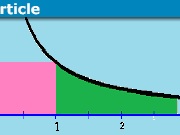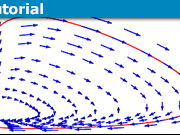How to Solve Nonhomogeneous Linear ODEs using Annihilators
My previous Insights article, Solving Homogeneous Linear ODEs using Annihilators, discussed several examples of homogeneous differential equations, equations of the form F(y, y’, y”, …) = 0. In this Insights article we will look at equations of the form F(y, y’, y”, …) = g(t), for certain functions g.
Ex. 1: y” – 4y’ + 3y = 5
For this example, we note two facts:
- The left side can be rewritten as ##(D^2 – 4D + 3)y##.
- The derivative of 5 = 0; that is, D(5) = 0.
If I apply the D operator to both sides, I get:
$$D(D^2 – 4D – 3)y = D(5) = 0$$
or, in factored form:
$$D(D – 3)(D – 1)y = 0$$
By “annihilating” the right side, I have converted the nonhomogeneous differential equation y” – 4y’ + 3y = 5 into a homogeneous differential equation, albeit of a higher order.
The characteristic equation of the new equation can be read off from the operator notation: ##r(r – 3)(r – 1) = 0##. The roots are r = 0, r = 3, and r = 1, so a fundamental solution set is ##\{e^{0t} = 1, e^{3t}, e^t\}##.
The general solution for the third-order homogeneous equation is ##y(t) = A \cdot 1 + c_1e^{3t} + c_2e^t##. You might wonder why I have different coefficients for the three fundamental solutions. The reason is that I want to keep the one (A) that came from the nonhomogeneous problem separate from the other two (##c_1## and ##c_2##).
Differentiating the solution twice, I get:
##y(t) = A \cdot 1 + c_1e^{3t} + c_2e^t##
##y'(t) = 3c_1e^{3t} + c_2e^t##
##y”(t) = 9c_1e^{3t} + c_2e^t##
Substituting back into the original differential equation, I get
##9c_1e^{3t} + c_2e^t – 4(3c_1e^{3t} + c_2e^t) + 3(A + c_1e^{3t} + c_2e^t) = 5##
##\Rightarrow (9c_1 – 12c_1 + 3c_1)e^{3t} + (c_2 – 4c_2 + 3 c_2)e^t + 3A = 5##
##\Rightarrow A = \frac 5 3##
The general solution to the original differential equation is ##y(t) = \frac 5 3 + c_1e^{3t} + c_2e^t##.
Note: If initial conditions had been given in this problem, we could find the constants ##c_1## and ##c_2##.
Ex. 2: ##y” – 4y’ + 3y = e^{2t}##
This equation can be rewritten as ##(D^2 – 4D + 3)y = e^{2t}##. Recall that the (D – 2) operator annihilates ##e^{2t}##. That is, ##(D – 2)e^{2t} = 0##.
If we apply the (D – 2) operator to both sides, we get ##(D – 2)(D^2 – 4D + 3)y = (D – 2)e^{2t} = 0##, which is a homogeneous equation, of third order.
Factoring the operators, we have ##(D – 2)(D – 3)(D – 1)y = 0##, so a fundamental solution set is ##\{e^{2t}, e^{3t}, e^t\}##. Note that the characteristic equation of the third-order, homogeneous equation is (r – 2)(r – 3)(r – 1) = 0.
The general solution of the homogeneous equation is ##y(t) = Ae^{2t} + c_1e^{3t} + c_2e^t##. If we substitute this into the original, nonhomogeneous equation, we get
$$(4A – 8A + 3A)e^{2t} + (9c_1 – 12c_1 + 3c_1)e^{3t} + (c_2 – 4c_2 + 3c_2)e^t = e^{2t}$$
$$\Rightarrow -Ae^{2t} = e^{2t} \Rightarrow A = -1$$
The general solution to the original nonhomogeneous equation is ##y(t) = -e^{2t} + c_1e^{3t} + c_2e^t##.
Ex. 3: ##y” – 4y’ + 3y = e^{3t}##
Rewriting the equation in operator notation, we have ##(D^2 – 4D + 3D)y = e^{3t}##, or ##(D – 3)(D – 1)y = e^{3t}##
We notice that the right side can be annihilated with the (D – 3) operator.
If we apply this operator to both sides, we get ##(D – 3)^2(D – 1) y = (D -3)e^{3t} = 0##, which is a third order, homogeneous equation.
One thing to notice is that, unlike the previous example, we now have a repeated factor ##(D – 3)^2##. This means that our fundamental set of solutions will be ##\{e^{3t}, te^{3t}, e^t\}##.
The general solution to the third order problem is ##y(t) = c_1e^{3t} + Ate^{3t} + c_2e^t##. The A coefficient on the middle term is to mark it as stemming from the second-order nonhomogeneous problem.
If we substitute this function and its first two derivatives into the second-order equation, we get A = 1/2. (Verification left to the reader.)
The general solution is ##y(t) = c_1e^{3t} + \frac 1 2 te^{3t} + c_2e^t##.
As before, if the problem included initial conditions, we could find the constants ##c_1## and ##c_2##.
Ex. 4: ##y” + 4y = te^{-t}##
In operator notation, the equation above is ##(D^2 + 4)y = te^{-t}##. The annihilator of the function on the right side is ##(D + 1)^2##. The reason for the exponent of 2 is because of the presence of t on the right side. The ##D + 1## operator annihilates ##e^{-t}##, and the ##(D + 1)^2## operator annihilates ##te^{-t}##.
Applying the ##(D + 1)^2## operator to both sides, we get ##(D + 1)^2(D^2 + 4)y = (D + 1)^2(te^{-t} = 0##. What was a second-order nonhomogeneous equation is now a fourth order homogeneous equation.
With a fourth-order equation, we expect the fundamental solution set to consist of four linearly independent solutions: ##\{e^{-t}, te^{-t}, \cos(2t), \sin(2t) \}##.
The general solution of the fourth-order equation is ##y(t) = Ae^{-t} + Bte^{-t} + c_1\cos(2t) + c_2\sin(2t)##.
I haven’t mentioned this before, but the first two terms in the equation above represent a particular solution to the original nonhomogeneous problem. The last two terms represent the complementary solutions — they are solutions of the related homogeneous equation y” + 4y = 0.
Instead of taking the first two derivatives of y(t) above, we can save some work by taking the derivatives of ##y_p(t) = Ae^{-t} + Bte^{-t}##, the particular solution to the nonhomogeneous equation, ##y” + y = te^{-t}##.
##y_p(t)## and its first two derivatives are:
##y_p(t) = Ae^{-t} + Bte^{-t}##
##y_p'(t) = -Ae^{-t} + Be^{-t} – Bte^{-t}##
##y_p”(t) = Ae^{-t} – Be^{-t} – Be^{-t} + Bte^{-t}##
Substituting into ##y” + y = te^{-t}##, we get:
##y_p”(t) + y_p = (2A – 2B)e^{-t} + 2Bte^{-t}##, or
A = B = 1/2
The general solution of the equation of this example is ##y(t) = \frac 1 2 e^{-t} + \frac 1 2 te^{-t} + c_1\cos(2t) + c_2\sin(2t)##.
Ex. 5: ##y” + y = 2\cos(t)##
In operator notation, this equation is ##(D^2 + 1)y = 2\cos(t)##. The annihilator of the right side is ##(D^2 + 1)##. (The coefficient of 2 on the right side has no effect on the annihilator we choose. If an operator annihilates f(t), the same operator annihilates k*f(t), for any constant k.)
Applying the ##(D^2 + 1)## operator to both sides, we get ##(D^2 + 1)(D^2 + 1)y = (D^2 + 1)(2\cos(t)) = 0##.
In slightly different form, we see that this is ##(D^2 + 1)^2y = 0##, a fourth-order homogeneous equation whose characteristic equation has repeated roots.
For the set of fundamental solutions, we choose ##\{ \cos(t), \sin(t), t\cos(t), t\sin(t)\}##. The general solution of the fourth-order homogeneous equation is ##y(t) = c_1 \cos(t) + c_2 \sin(t) + At\cos(t) + Bt\sin(t)##. As before the terms with the coefficients of A and B make up the particular solution. The other two terms make up the complementary function, the general solution of the related homogeneous problem, y” + y = 0.
##y_p(t)## and its first two derivatives are:
##y_p(t) = At\cos(t) + Bt\sin(t)##
##y_p'(t) = A\cos(t) – At\sin(t) + B\sin(t) + Bt\cos(t)##
##y_p”(t) = -A\sin(t) – A\sin(t) – At\cos(t) + B\cos(t) + B\cos(t) – Bt\sin(t) = -2A\sin(t) – At\cos(t) + 2B\cos(t) – Bt\sin(t)##
Substituting into the nonhomogeneous equation ##y” + y = 2\cos(t)##, we can simplify things to ##-2A\sin(t) + 2B\cos(t) = 2\cos(t) \Rightarrow A = 0## and ##B = 1##, so ##y_p(t) = t\sin(t)##.
The general solution for the equation of this example is ##y(t) = c_1\cos(t) + c_2\sin(t) + t\sin(t)##.
The following table lists several operators, together with the functions that they annihilate.
| Operator | Function that is annihilated |
|---|---|
| ##D, D^2, D^3, \dots ## | 1, t, ##t^2##, ##t^3##, … |
| ##D – k, (D – k)^2, (D – k)^3, \dots## | ##e^{kt}, te^{kt}, t^2e^{kt},## … |
| ##(D^2 + 1)## | cos(t), sin(t) |
| ##(D^2 + 1)^2## | tcos(t), tsin(t) |
| ##(D^2 + 4)## | cos(2t), sin(2t) |
Former college mathematics professor for 19 years where I also taught a variety of programming languages, including Fortran, Modula-2, C, and C++. Former technical writer for 15 years at a large software firm headquartered in Redmond, WA. Current associate faculty at a nearby community college, teaching classes in C++ and computer architecture/assembly language.
I enjoy traipsing around off-trail in Olympic National Park and the North Cascades and elsewhere, as well as riding and tinkering with my four motorcycles.






“I think I found 2 small typos in the post. In ex 1, you said
I think in the 2nd last step ##(c_2–4c_2+3c_2)e^t## should be over there instead of ##(c_2–4c_2+c_2)e^t##.
In ex 4, you said
The 2nd solution should be ##te^{-t}## right?”
Thanks for spotting these — I have fixed both of them.
Even though I looked through this stuff before publishing it, it’s still hard to catch everythin, especially when you’re working with LaTeX .
I think I found 2 small typos in the post. In ex 1, you said
”
Substituting back into the original differential equation, I get
##9c_1e^{3t}+c_2e^t–4(3c_1e^{3t}+c_2e^t)+3(A+c_1e^{3t}+c_2e^t)=5
⇒(9c_1–12c_1+3c_1)e^{3t}+(c_2–4c_2+c_2)e^t+3A=5
⇒A=5/3##
”
I think in the 2nd last step ##(c_2–4c_2+3c_2)e^t## should be over there instead of ##(c_2–4c_2+c_2)e^t##.
In ex 4, you said
”
With a fourth-order equation, we expect the fundamental solution set to consist of four linearly independent solutions: {##e^{−t},te−t,cos(2t),sin(2t)## }.
”
The 2nd solution should be ##te^{-t}## right?
“Great entry! Please make some more math tutorials Mark!!”
Thank you! I have another one in mind coming soon, and probably some more after that.